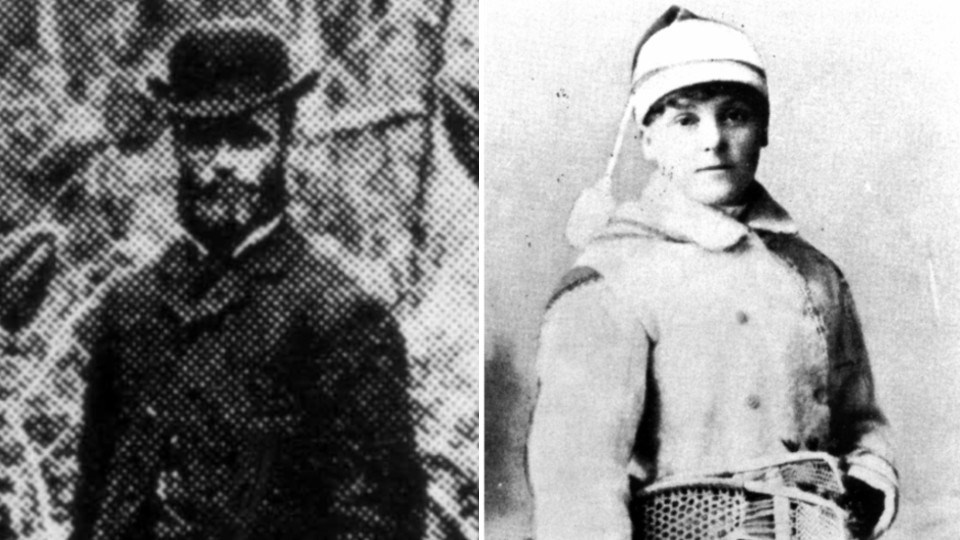Editor’s note: This is the second part of a two-part series on pioneering Sudbury couple Dr. William and Florence Howey. You can read Part One here.
Sudbury's Howey Drive, one of the main arteries that connects downtown to Minnow Lake, is named for Dr. William Howey and his wife, Florence.
The Howeys are considered the first permanent settlers of Sudbury having arrived in July 1883, a few months after the construction crew building the railway.
In her book, "Pioneering on the CPR," Florence wrote about the early years in the frontier town. The book was published in 1938, two years after her death at age 80, and is an important source of local history.
Howey was 27 and a recent graduate of medical school at McGill when he joined CPR as a company doctor to look after the army of men doing dangerous work in the wilds of northeastern Ontario. The Howeys' first home was a log cabin, located at Elm and Lorne streets. The young couple liked Sudbury and, after a brief move to North Bay around 1886, decided to settle here. They moved into a pleasant arts and crafts home on the corner of Howey and Cartier Street. The house is still standing and is well cared for by its owner.
The doctor's services were secured by the Dominion Mineral Company and the H.H. Vivian Company and later the Mond Nickel Company before he went into private practice around 1910.
Howey, who died in 1929, was Sudbury's first medical officer of health and provided services at Sudbury Jail. He also served on the provincial board of health and was a member of the Ontario Medical Society.
One of the original "old boys" who shepherded the pioneer community, Howey served on Sudbury town council. He was one of the “company of 100 associates” who petitioned to have Sudbury incorporated as a town in 1893. He was also a Mason and is considered the "father" of Nickel Lodge 427.
In her book, Florence recalled her husband, an amateur geologist, may have been the first person to discover Sudbury's resources motherlode, a story that has been repeated by local historians many times.
"In the fall of 1883, Dr. Howey had talked a good deal about the possibility of our rocks containing something valuable and had shown the bright specks in bits he had picked up where blasting was going on. This created quite an interest and many pockets were worn out carrying pretty pebbles, and window sills in the boarding houses were piled with chunks of rock big and small, but after Dr. Selwyn's (director of Geological Survey of Canada), visit and his discouraging report on the samples he had tested, the excitement died down, and we heard nothing more of prospective wealth in our hills.
"However … hopeful prospectors came in to see for themselves. The result was that Tom Murray of Pembroke applied for a lot somewhere in McKim Township, under the Mining Act … The samples of ore ,which induced Mr. Murray to take up his claim, came from the very rock cut where Dr. Howey picked up sample ore." (Murray Mine was the first mine to operate in the Sudbury area.)
The Howeys owned a beautiful 277-acre property between lakes Ramsey and Nepahwin where they built a summer camp they called Idyl in the Wild or Idylwylde. This property was sold to the Idylwylde Golf and Country Club, which opened in 1923, and for a time the Howey cabin was used as a clubhouse.
The Howey camp property, developed into the golf course and eight private lots, in now one of the city's most desirable neighbourhoods, sold for $15,000, said Juanita Stolte, whose family owned a camp next to the Howeys.
In the 1960s when Stolte and her husband, John, built a permanent home on that property, they acquired the lot where the Howey log cabin was located. It was moved to accommodate their home but it was not torn down. The Stoltes have offered to donate the century-old building to the city.
The Howeys did not have any children, but for a time, their niece, Florence Northrop, lived with them. Northrop met and married Willian MacLeod, a Sudbury mining engineer from Scotland and they lived in a stately home on John Street overlooking Ramsey with twin daughters, Elizabeth and Florence Jean. The F. Jean MacLeod Butterfly Gallery at Science North is named for its benefactor, the Howeys' great-niece.
Florence Howey lived the busy life of a prominent doctor's wife. She delighted in the beauty of northeastern Ontario, enjoyed fishing and canoeing, picking blueberries, and relaxing at her camp. She witnessed so much as Sudbury evolved from a construction camp to a multicultural city of 20,000 by the time of her death.
Florence concludes "Pioneering on the CPR" with sentiments familiar to many. "We came here for a little while, and here we are yet. Many people have come and gone. They alight for a short time and then flit away. Very few of the oldtimers are left. Many have gone to their heavenly home. I have never really wanted to go back south, and now I never shall. I have good friends here, such friends as I am sure I should never find again, and I have no greater desire now than to end my days in their midst."
A digital file of "Pioneering on the CPR" is available for $10 from the Sudbury District Branch of the Ontario Genealogical Society.
Vicki Gilhula is a freelance writer. She is a former editor of Northern Life and Sudbury Living magazine, and has a special interest in local history. Then and Now is made possible by our Community Leaders Program.
